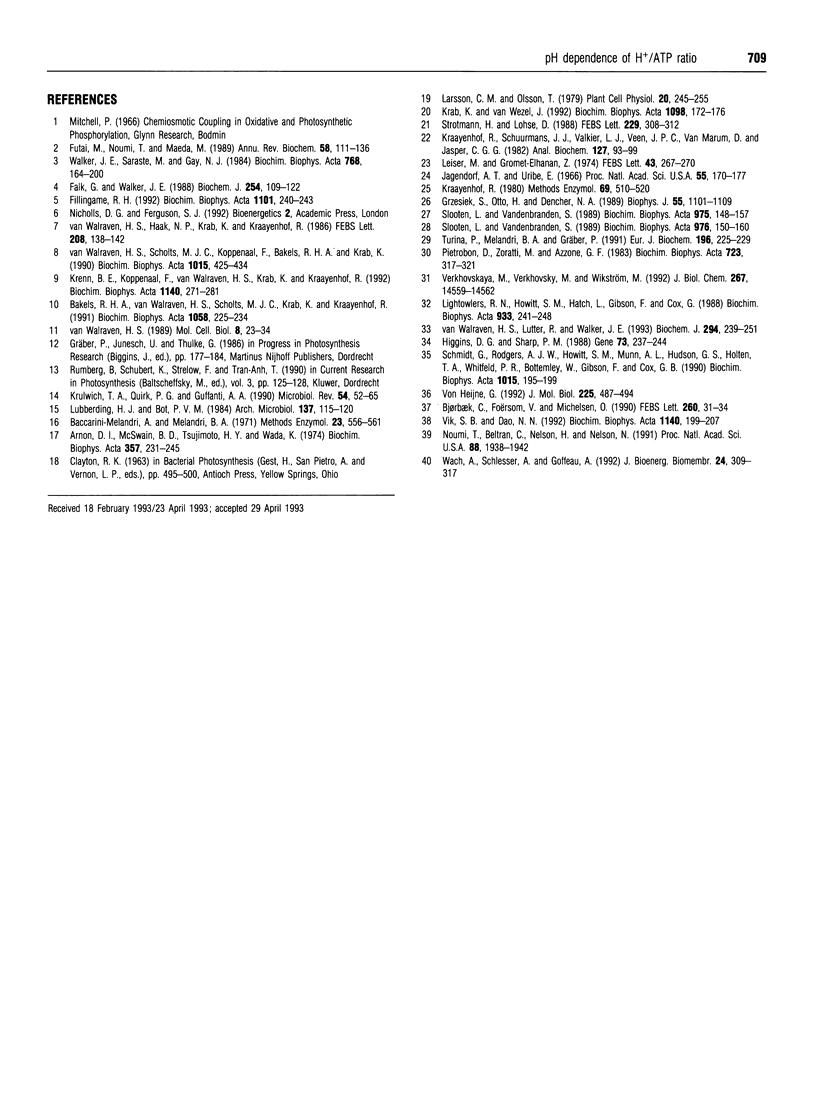Abstract
The stoichiometry between proton translocation and ATP synthesis/hydrolysis was studied in two different photosynthetic prokaryotes, the thermophilic cyanobacterium Synechococcus 6716 and the purple bacterium Rhodospirillum rubrum. The H+/ATP ratio was determined by acid-base transitions as a function of the external pH. The H+/ATP ratio of the Synechococcus 6716 ATP synthase was found to increase with increasing pH. In contrast, in R. rubrum this ratio decreased with increasing pH. These results were qualitatively supported by experiments using the fluorescence probe 9-aminoacridine. The degree of coupling between the H+ flux and the ATP synthesis/hydrolysis reaction is apparently modulated by the conditions under which the proton pump has to work. Such modulation of the H+/ATP ratio may be of physiological significance for an organism, for example when ATP synthesis is necessary at low proton-electrochemical potential difference (delta mu H+ levels). The different pH dependencies of the H+/ATP ratios in these organisms are considered in relation to the differences in the charged amino acids that are present in the F0 subunits a and c.
Full text
PDF




Selected References
These references are in PubMed. This may not be the complete list of references from this article.
- Arnon D. I., McSwain B. D., Tsujimoto H. Y., Wada K. Photochemical activity and components of membrane preparations from blue-green algae. I. Coexistence of two photosystems in relation to chlorophyll a and removal of phycocyanin. Biochim Biophys Acta. 1974 Aug 23;357(2):231–245. doi: 10.1016/0005-2728(74)90063-2. [DOI] [PubMed] [Google Scholar]
- Bjørbaek C., Foërsom V., Michelsen O. The transmembrane topology of the a [corrected] subunit from the ATPase in Escherichia coli analyzed by PhoA protein fusions. FEBS Lett. 1990 Jan 15;260(1):31–34. doi: 10.1016/0014-5793(90)80058-q. [DOI] [PubMed] [Google Scholar]
- Falk G., Walker J. E. DNA sequence of a gene cluster coding for subunits of the F0 membrane sector of ATP synthase in Rhodospirillum rubrum. Support for modular evolution of the F1 and F0 sectors. Biochem J. 1988 Aug 15;254(1):109–122. doi: 10.1042/bj2540109. [DOI] [PMC free article] [PubMed] [Google Scholar]
- Fillingame R. H. Subunit c of F1F0 ATP synthase: structure and role in transmembrane energy transduction. Biochim Biophys Acta. 1992 Jul 17;1101(2):240–243. [PubMed] [Google Scholar]
- Futai M., Noumi T., Maeda M. ATP synthase (H+-ATPase): results by combined biochemical and molecular biological approaches. Annu Rev Biochem. 1989;58:111–136. doi: 10.1146/annurev.bi.58.070189.000551. [DOI] [PubMed] [Google Scholar]
- Grzesiek S., Otto H., Dencher N. A. delta pH-induced fluorescence quenching of 9-aminoacridine in lipid vesicles is due to excimer formation at the membrane. Biophys J. 1989 Jun;55(6):1101–1109. doi: 10.1016/S0006-3495(89)82907-8. [DOI] [PMC free article] [PubMed] [Google Scholar]
- Higgins D. G., Sharp P. M. CLUSTAL: a package for performing multiple sequence alignment on a microcomputer. Gene. 1988 Dec 15;73(1):237–244. doi: 10.1016/0378-1119(88)90330-7. [DOI] [PubMed] [Google Scholar]
- Jagendorf A. T., Uribe E. ATP formation caused by acid-base transition of spinach chloroplasts. Proc Natl Acad Sci U S A. 1966 Jan;55(1):170–177. doi: 10.1073/pnas.55.1.170. [DOI] [PMC free article] [PubMed] [Google Scholar]
- Kraayenhof R., Schuurmans J. J., Valkier L. J., Veen J. P., Van Marum D., Jasper C. G. A thermoelectrically regulated multipurpose cuvette for simultaneous time-dependent measurements. Anal Biochem. 1982 Nov 15;127(1):93–99. doi: 10.1016/0003-2697(82)90149-x. [DOI] [PubMed] [Google Scholar]
- Krulwich T. A., Quirk P. G., Guffanti A. A. Uncoupler-resistant mutants of bacteria. Microbiol Rev. 1990 Mar;54(1):52–65. doi: 10.1128/mr.54.1.52-65.1990. [DOI] [PMC free article] [PubMed] [Google Scholar]
- Leiser M., Gromet-Elhanan Z. Demonstration of acid-base phosphorylation in chromatophores in the presence of a K+ diffusion potential. FEBS Lett. 1974 Aug 1;43(3):267–270. doi: 10.1016/0014-5793(74)80658-7. [DOI] [PubMed] [Google Scholar]
- Lightowlers R. N., Howitt S. M., Hatch L., Gibson F., Cox G. The proton pore in the Escherichia coli F0F1-ATPase: substitution of glutamate by glutamine at position 219 of the alpha-subunit prevents F0-mediated proton permeability. Biochim Biophys Acta. 1988 Apr 22;933(2):241–248. doi: 10.1016/0005-2728(88)90031-x. [DOI] [PubMed] [Google Scholar]
- Noumi T., Beltrán C., Nelson H., Nelson N. Mutational analysis of yeast vacuolar H(+)-ATPase. Proc Natl Acad Sci U S A. 1991 Mar 1;88(5):1938–1942. doi: 10.1073/pnas.88.5.1938. [DOI] [PMC free article] [PubMed] [Google Scholar]
- Schmidt G., Rodgers A. J., Howitt S. M., Munn A. L., Hudson G. S., Holten T. A., Whitfeld P. R., Bottomley W., Gibson F., Cox G. B. The chloroplast CF0I subunit can replace the b-subunit of the F0F1-ATPase in a mutant strain of Escherichia coli K12. Biochim Biophys Acta. 1990 Feb 2;1015(2):195–199. doi: 10.1016/0005-2728(90)90020-5. [DOI] [PubMed] [Google Scholar]
- Slooten L., Vandenbranden S. ATP-synthesis by proteoliposomes incorporating Rhodospirillum rubrum F0F1 as measured with firefly luciferase: dependence on delta psi and delta pH. Biochim Biophys Acta. 1989 Sep 28;976(2-3):150–160. doi: 10.1016/s0005-2728(89)80224-5. [DOI] [PubMed] [Google Scholar]
- Turina P., Melandri B. A., Gräber P. ATP synthesis in chromatophores driven by artificially induced ion gradients. Eur J Biochem. 1991 Feb 26;196(1):225–229. doi: 10.1111/j.1432-1033.1991.tb15808.x. [DOI] [PubMed] [Google Scholar]
- Van Walraven H. S., Lutter R., Walker J. E. Organization and sequences of genes for the subunits of ATP synthase in the thermophilic cyanobacterium Synechococcus 6716. Biochem J. 1993 Aug 15;294(Pt 1):239–251. doi: 10.1042/bj2940239. [DOI] [PMC free article] [PubMed] [Google Scholar]
- Verkhovskaya M., Verkhovsky M., Wikström M. pH dependence of proton translocation by Escherichia coli. J Biol Chem. 1992 Jul 25;267(21):14559–14562. [PubMed] [Google Scholar]
- Vik S. B., Dao N. N. Prediction of transmembrane topology of F0 proteins from Escherichia coli F1F0 ATP synthase using variational and hydrophobic moment analyses. Biochim Biophys Acta. 1992 Dec 7;1140(2):199–207. doi: 10.1016/0005-2728(92)90009-q. [DOI] [PubMed] [Google Scholar]
- Wach A., Schlesser A., Goffeau A. An alignment of 17 deduced protein sequences from plant, fungi, and ciliate H(+)-ATPase genes. J Bioenerg Biomembr. 1992 Jun;24(3):309–317. doi: 10.1007/BF00768851. [DOI] [PubMed] [Google Scholar]
- Walker J. E., Saraste M., Gay N. J. The unc operon. Nucleotide sequence, regulation and structure of ATP-synthase. Biochim Biophys Acta. 1984 Sep 6;768(2):164–200. doi: 10.1016/0304-4173(84)90003-x. [DOI] [PubMed] [Google Scholar]
- von Heijne G. Membrane protein structure prediction. Hydrophobicity analysis and the positive-inside rule. J Mol Biol. 1992 May 20;225(2):487–494. doi: 10.1016/0022-2836(92)90934-c. [DOI] [PubMed] [Google Scholar]


